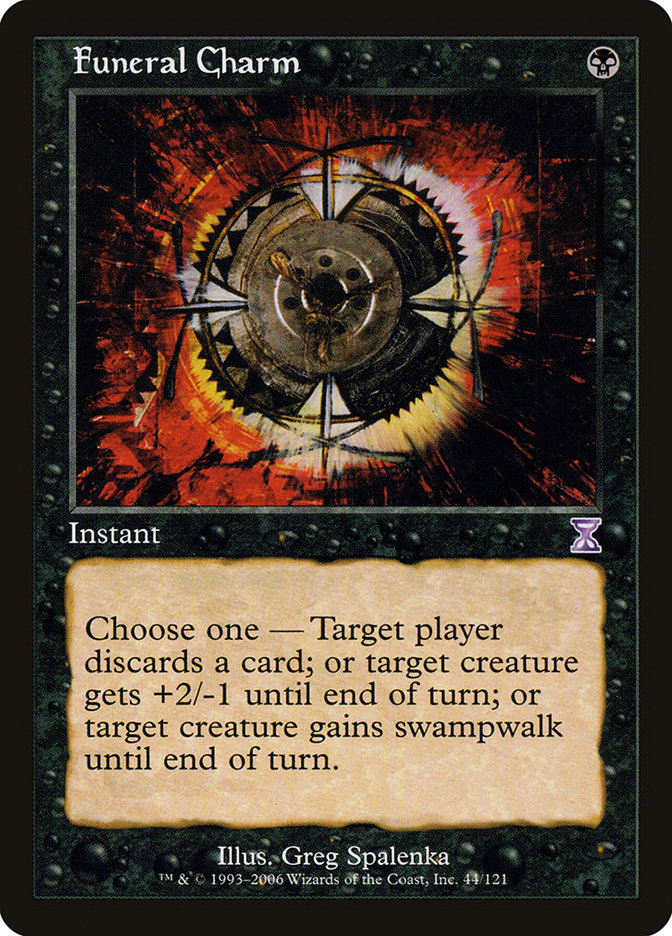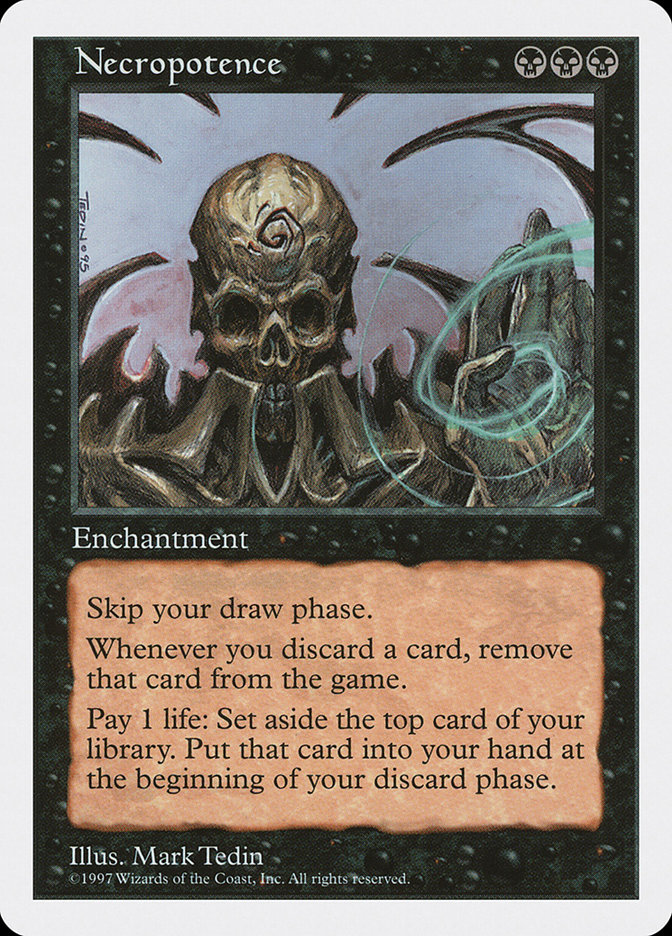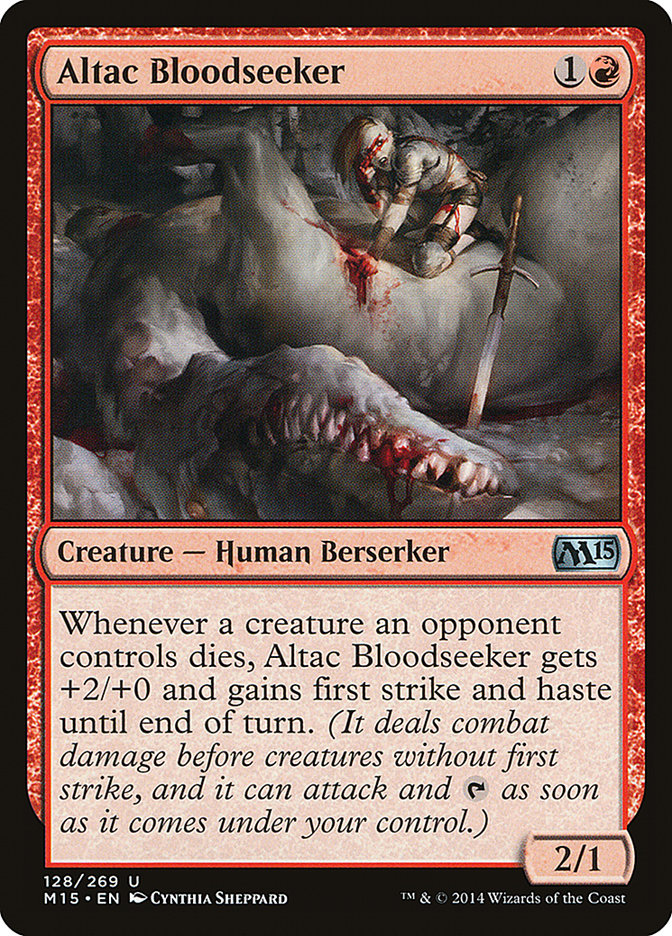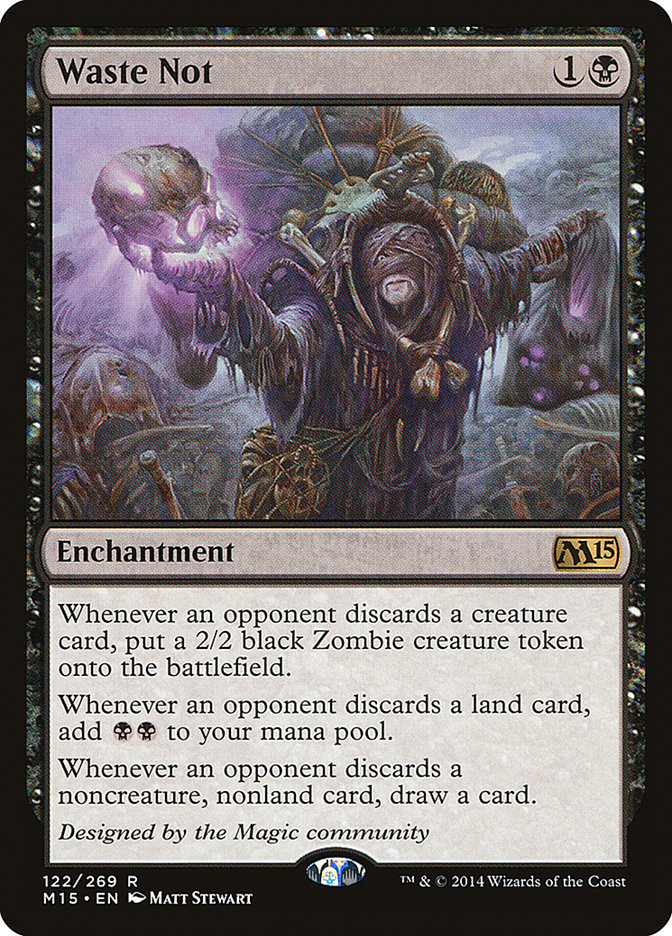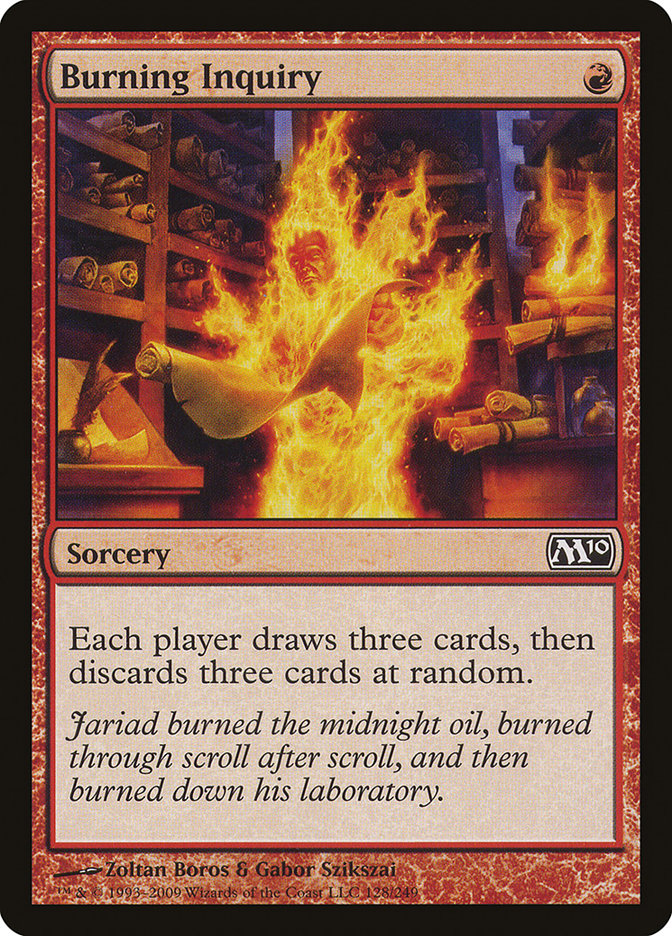Embarrassment is tied into one of the things that I think is incredibly important when it comes to succeeding at Magic.
Tournament Magic is full of those moments where you play a card that looks absurd. Dime rares and marginal cards can become wildly important once people
realize that they aren’t a joke. At other times, a card could have already proven itself, but then it falls so far off the radar that no one
remembers it.
Take a card I’m very fond of right now:
I’ve had countless decks over the years that have included the card, and it is clear to me that Funeral Charm is one of those cards that is worth
considering when you’re looking for flexibility. Funeral Charm is a lot worse than a lot of cards at doing any particular task, but two of the three tasks
it does accomplish are quite solid. It only costs one mana, and sometimes you don’t have either of the other available colors or you simply can’t afford to
overload on removal because of the metagame. I don’t think it belongs in every Modern Rock (Black/Green Midrange) deck, but there are many which I think
should be using it.
Many times when I’ve shown people my current version of The Rock, they look at my Funeral Charms and think I must be smoking something. They don’t want to
play the card, and there are a few reasons for this.
One large part of the reason is that they haven’t seen it do much of anything lately. They don’t know that this is a card that has proven itself in the
past. In a field with Counter-Oath (where Enlightened Tutor, Brainstorm, Oath of Druids, Force of Will, and Counterspell were legal), Royce Chai had the third best finish in the Extended portion of Worlds playing this deck:
Spells (35)
- 4 Hymn to Tourach
- 2 Yawgmoth's Will
- 4 Duress
- 3 Diabolic Edict
- 3 Cursed Scroll
- 4 Dark Ritual
- 4 The Rack
- 2 Pox
- 2 Demonic Consultation
- 3 Funeral Charm
- 4 Urza's Bauble
Sideboard

Sometimes, you just need a card that does something, even if that card, overall, is fairly weak. It is worth noting that in this deck there are several
other cards that, even if only for a brief time, were considered weak. Take Demonic Consultation, for example. This card spent a short window thought of as
nearly unplayable, up until it was a huge part of why people played black decks, often to get another card that was thought of as unplayable for a little
while:
None of this means that Funeral Charm is decidedly good in all eras of Magic. One shortcut that we can take in deckbuilding, however, is to look at the
past, and see if it gives us any hints about what else might be worth thinking about. In my own experience with Funeral Charm at Grand Prix Chicago 2012, I
was in the money with Funeral Charm in my Rock list, so I don’t have to look very far – my own fairly recent experience – to feel confident with the card.
This is a great reason to try to be a student of Magic history. If you listen to the most recent CEDTalks, GerryT compared an idea in a deck he was
working on now to the performance of a deck from the past. Whether Gerry is correct or not in his comparison of Jund Planeswalkers to
Fires decks from fifteen years ago doesn’t matter. The point is what was true in the past about manabases (or anything else about a deck) may be true
today.
“If I have seen further it is by standing on the shoulders of giants.”
– Sir Isaac Newton to Robert Hooke, 1676
In Magic, even if one doesn’t take the work of yesteryear as the work of “giants”, at the very least there can be some amount of wisdom we can glean. The most recent Pro Tour offered a number of valuable
lessons to those willing to do the looking. If decks succeed or fail, the work that was done on them can be incredibly valuable in understanding
prospective decks.
As an example, recently Brian Kowal asked to look at my old version
of BluManji. He knew that I’m not currently advocating the list for Modern, but that wasn’t the point. He also knew that the deck succeeded at
doing some things, and maybe I’d figured out things what he hadn’t yet, and he could save himself the extra time.
In this case, this meant an inclusion of Glen Elendra Archmage and the decision to abandon the Fauna Shaman shell. Decks, by their very nature, tend to
lead you to them on their own steam. This is, in part, because the raw materials of these decks exist whether we find them or not (one of the reasons I
currently prefer to talk about this process as deck discovery instead of deck design or building). What he gained was more evidence about what was fundamental, and he discarded things that didn’t
apply in the now while using things that did.
When Reid Duke built this deck, it existed in a very particular moment in time. However, it can give us a lot of information. Looking at this deck, for
example, it is reasonable to assume that without other fixing, you’re going to need thirteen green sources for a Farseek deck to function. This will likely
be true going into the far future if another deck like this exists. Amass the Components is certainly a card worthy of consideration. Multiple colors can
be supported with a particular number of mana for each part. A “Quicken” effect is reasonable, even at high cost.
Things like this were influential when I made a successful deck (though much less successful than Reid’s) that ran an entirely different color scheme. This
wildly different deck would get me a lot of wins in some minor events, and it got Jackie Lee a Top 8 at a $5K.
Creatures (4)
Planeswalkers (3)
Lands (25)
Spells (28)

The manabase was designed to be more stable than Reid’s (based on his numbers of various mana), and it certainly was surprising how easy it was to
cast all of your spells. I initially had the Amass the Components, in part encouraged by Reid’s success, and in the end, Jackie did end up cutting it in
the final version (a change I’m uncertain of to this day), but the overall concept of the deck was sound. Jackie was defeated by Jund but still had a great
showing.
This deck would, in turn, inform my building of the Elixir of Immortality decks that I would end up playing for much of the last year.
If we look to the past, we can take those cards that someone else, without that knowledge, might be embarrassed to sleeve up and shuffle. But being
embarrassed by a card is the wrong way to examine it. Who cares if a card looks dumb? Does it do the work? That’s all that matters.
In both Limited and Constructed, when you’re working on decks, the best approach involves balancing two halves of the same whole:
you must stubbornly refuse to be concerned about how something looks and also have the discipline to heed the best available data that
you have at your disposal.
A lot of people fail the first test because they are afraid of being embarrassed. They are afraid of being laughed at, and one result of this fear is that
they will often lag behind the crest on any new decks because an idea doesn’t obviously appear to be good.
Less people fail the second test only because less people are trying out new things. Among that group, however, failure to heed the data is a huge
problem. It is so easy to get caught up in the excitement of the creation/discovery process that you start to fall in a kind of love, of sorts, with the
deck you are working on. Learning how to kill your darlings is really hard when you’re only just establishing yourself as someone who comes up
with cool new ideas.
There is excitement in a new idea. There is also a kind of intrinsic power to going rogue -when you do things people aren’t used to seeing, whether it is a samurai submerging into the water during a duel or playing an unusual deck, your
opponent is going to be at a distinct disadvantage. At the same time, it is very easy to get tricked by your own tricks and think that you are doing
something intrinsically powerful, only to discover that another skilled player might never fall prey to your rogue antics, and suddenly the great
matchup that you thought you had is exposed as something less that ideal.
If you are one of those creative types that is always pushing the envelope on decks, these are the moments that you need to pay attention to.
Ignoring embarrassment is a key component to successful experimentation. Having the discipline to abandon the exciting new idea is another. Importantly, you have to be willing to change your mind.
In the preparation leading up to M15, I had a moment of excitement around a card that I thought might potentially be mindblowing.
I dropped this card into play in a draft, and it just struck me as a potential card to drop into the Red list I played to the Top 8 of SCG Milwaukee last
year. In that draft, we definitely messed up some of the “reality” of the game (I sacrificed my own Generator Servant to trigger the Bloodseeker, not
realizing it didn’t work), but the Bloodseeker felt like an inspiration.
Trying it out, one of the very first games it was in play, I was playing versus Jund Monsters, and I cast a game 1 overloaded Mizium Mortars into a bunch
of Xenagos Satyrs and friends, like Sylvan Caryatid.
Altac Bloodseeker killed them on the spot. And from a high life total.
After that though, it didn’t really replicate. Eventually, as exciting as it was, I ended up going down a different path.
In the prep for Pro Tour M15, I gave Matt Sperling my Burn deck that I’d been working on with Ronny Serio. Sperling seemed to get interested in Burn after
seeing the Burn list Tomoharu Saito posted on Twitter (“New R/W Burn”, Saito called it).
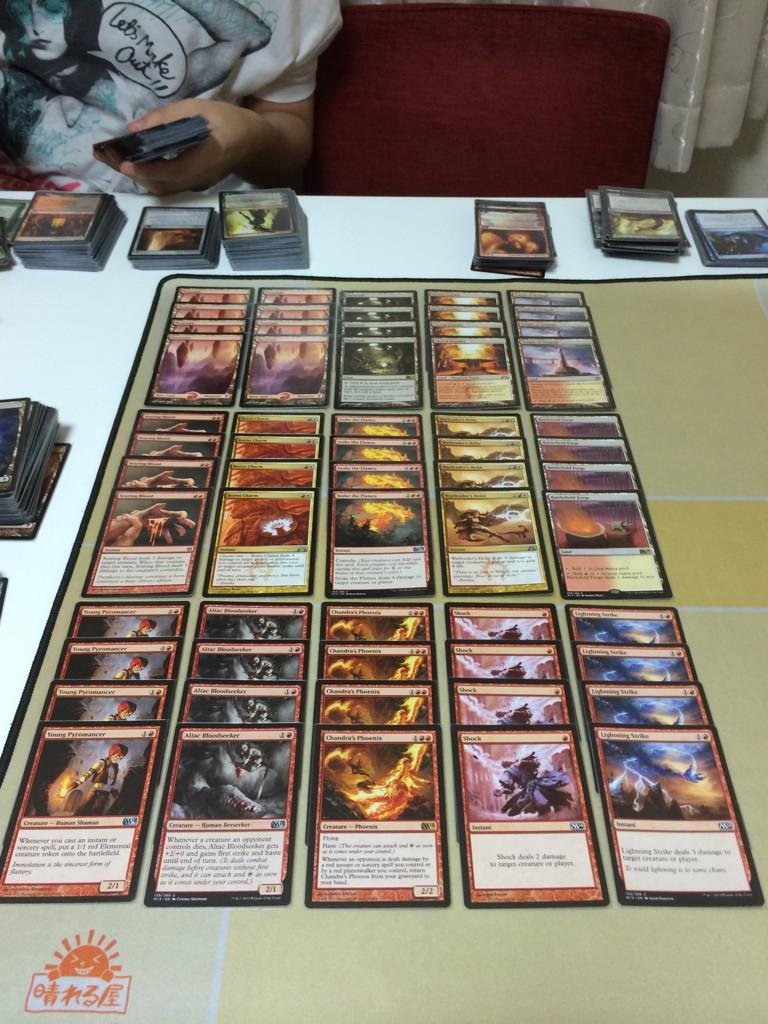
Creatures (12)
Lands (24)
Spells (24)

At some point Sperling took this list, replaced Bloodseeker with Satyr Firedrinker and started falling in love with Burn. All three of our lists were
pretty damn close, and each had the “12-4s” that I think make the deck work. As he worked on it, he slowly drifted pretty close to the deck that Serio and
I had made (three spells off). In the end, Bloodseeker didn’t make the cut (now in two decks), and that was largely because of the incentives for other
decks.
Since then, my own list has slightly nudged closer to what Sperling played. Interestingly though, as I’ve continued to work on Burn, Altac Bloodseeker has
started to feel more appealing. In great measure, this is partly because there are a few slots in my current version of Burn that are more flexible, and
I’m just not in love with Eidolon of the Great Revel in the main currently.
I don’t know if the two Altac Bloodseeker are going to be in my final list. There isn’t much time until Standard will be radically different, but in the
current format, in the now, I know that depending on the specifics of the metagame, Altac Bloodseeker is going to be on my radar as a potential inclusion.
One of my most recent mind-changing experiences happened recently in Modern. I was playing The Rock. I cast a Thoughtseize on turn 2 and saw that my
opponent was playing 8-Rack-the discard deck with four The Rack and four Shrieking Affliction.
I felt pretty great about how things were going; I was stalled by an Ensnaring Bridge, but I felt firmly in control. And then they cast Waste Not and a
Burning Inquiry they’d been sandbagging.
Suddenly, the Burning Inquiry they’d played on previous turns no longer seemed like a weak Ensnaring Bridge enabler. Suddenly, I felt like I was going to
lose.
And I did lose.
I can’t say that I can get behind the deck at large, but I know that even though I once thought Waste Not was a joke, now I’m actually brewing with it.
I know that the deck(s) that might come out of this exercise might never end up being sleeved up for a tournament. I might not ever recommend it to a
friend. But I’m going to experiment with it because the triggered abilities on Waste Not actually feel like they might be potent enough to do something
with.
If it ends up being good, you can expect I’ll let you know. I know that The Rack decks have worked in the past, and maybe with the right components they
can work again. But I’m not going to be embarrassed to try it out, and I’m not going to keep beating my head against a wall insisting that it should win if
it doesn’t.
And if you get Magic, that’s the right way to be about it.

